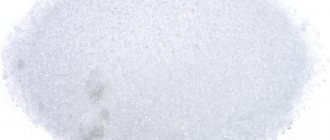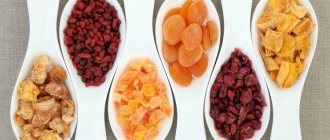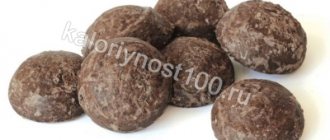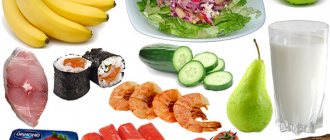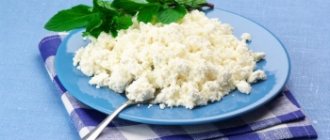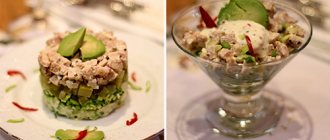Chemical composition of cherries
Ripe fruits contain sugars (glucose and fructose), vitamins A, B1,B6, C, PP, organic acids (citric, malic, salicylic). The berries contain trace elements: calcium, magnesium, iron, copper, potassium, chromium and many others.
How healthy cherries are, whose caloric content is low and whose nutritional value is high due to sugars, can be judged by the decoding of each of the vitamins:
- A - retinol, produces immunity in the body to pathogenic microbes, regulates the functions of the retina.
- B1 – thiamine, is responsible for the functioning of the nervous and immune systems, controls energy metabolism.
- B6 – pyridoxine, regulates protein metabolism. Promotes the release of excess fluid from the body, which lowers blood pressure. In addition, it is prescribed to diabetics, hypertensive patients and pregnant women with toxicosis.
- C – ascorbic acid, prevention of viral infections, increases appetite, especially in children.
- PP - nicotinic acid of natural origin, regulates cholesterol levels in the blood.
How many calories are in cherries?
Ripe cherries have a red or dark red color and fairly dense flesh. The taste of this berry can be sour or sweet and sour depending on the degree of ripeness and variety. At the same time, the number of calories in cherries remains unchanged. It is 52 kcal per 100 g of product. As you can see, cherries are a fairly dietary product, the consumption of which will not affect your waistline in any way. In addition to such a low calorie content, this berry has many other beneficial properties that allow it to be widely used for the prevention and treatment of diseases.
The composition of cherries is unique in its own way. 100 g of product contains water (85 g), proteins (10 g), fats (0.1 g), carbohydrates (10.5 g). In addition, cherries contain many organic acids, such as: malic, citric, salicylic, succinic, folic. As for the presence of vitamins and minerals, here too this small berry is a real record holder. It contains micro- and macroelements (zinc, iodine, iron, copper, fluorine, calcium, boron, manganese, phosphorus, potassium, magnesium), as well as sugars (glucose, sucrose, fructose), and pectin substances. The number of vitamins is also large, these are vitamins of group A, E, C, PP and vitamins of group B (B2, B1, B3).
As you can see, cherries are an important source of nutrients for the human body. This fact, combined with the low calorie content of cherries, makes them an indispensable product on the table of every person who cares about their health. Cherries also contain a very important substance - oxycoumarin, which helps normalize blood clotting function. This berry also contains a large amount of iron. Therefore, it is recommended for people with anemia.
As you can see, the composition of cherries makes them not only tasty, but also a very healthy berry. Therefore, during the season you should consume a large amount of cherries in order to fill the body with useful substances and microelements for the coming year. Considering how many calories there are in cherries, the amount of this berry in the daily menu can be practically unlimited. However, you should be aware of the increased acid content, which can negatively affect those who suffer from gastrointestinal diseases.
Benefit for health
The increased content of iron, copper and magnesium in fruits eliminates the risk of anemia. It has a good effect on the heart, strengthens blood vessels, and relieves headaches. It has a good effect on the intestines and respiratory system. Recommended for boosting immunity.
An aqueous infusion of cherry pulp is an excellent thirst-quenching and soothing drink. It is especially popular in the south, in hot climates. To enjoy a tonic and refreshing cherry drink, you need to mash a few berries in a glass and pour cold water over them. It turns out to be an excellent remedy that has a beneficial effect on the entire body as a whole, giving a surge of strength and good mood.
If you eat 200-300 g of cherries at night during the season, then a restful and sound sleep is guaranteed.
How to burn calories from 100 g of frozen cherries
For example, to burn all the calories from 100 grams of frozen cherries, you will need 4 minutes of running or 44 minutes of sleep.
>’> >’> >’> >’> >’> >’> >’> >’> >’> >’> >’> >’> >’> >’> >’>
| Activity | Calorie content per day per 100 g | |
| Dream | 0 h 44 min | 3% |
| Meditation | 0h 39 min | 3% |
| Rest | 0h 36 min | 3% |
| Reading books, Internet | 0 h 30 min | 2% |
| Sex | 0h 19 min | 1% |
| Yoga, Pilates | 0 h 12 min | 1% |
| Dancing | 0 h 12 min | 1% |
| Walking | 0 h 10 min | 1% |
| Football | 0h 06 min | 0% |
| Swimming | 0h 06 min | 0% |
| Abs workout | 0h 05 min | 0% |
| Power training | 0h 05 min | 0% |
| A ride on the bicycle | 0h 05 min | 0% |
| Jumping rope | 0h 04 min | 0% |
| Run | 0h 04 min | 0% |
Cherry in folk medicine
In folk medicine, freshly squeezed cherry juice is widely used as an expectorant for tracheitis or bronchitis. In addition, this drink increases appetite, eliminates fermentation processes in the intestines, and has a mild laxative property. Cherries, which have a low calorie content, are excellent for preparing syrup for diluting dosage forms (potions, tinctures, decoctions) and improving their unpleasant taste.
A decoction of young cherry leaves in milk helps with damage to the skin, mucous membranes and nosebleeds. If you place a napkin soaked in the broth on the sore spot, the wound will heal quickly.
From all of the above, we come to the conclusion that cherries, whose caloric content allows them to be used without limitation, are very good for health.
Useful properties of cherries
Cherries not only taste good, but also have many health benefits. The pulp of cherries contains bactericidal substances. The red pigment called anthocyanin is perfectly absorbed, and coumarin helps reduce blood clotting. Therefore, it is simply necessary to eat the fruit, no matter what calorie content the cherry has. Eating juicy berries not only suppresses depression, but is also a serious preventative against atherosclerosis.
Cherries contain a sufficient amount of calcium, iron, copper, and magnesium. Vitamins C, PP, A, pectin and tannins can also be obtained by eating a tart berry. Even the seeds of this fruit are not thrown away, since they also have beneficial properties and are successfully used in aromatherapy in the form of essential oil.
In terms of the amount of vitamins and beneficial microelements, cherries are second only to strawberries. You don’t have to worry about your figure, being content with the taste of wine cherries; its calories are only 52 kcal. Therefore, even a dozen cherries will not aggravate your situation and will not add centimeters to your waist.
Cherry is a vitamin product whose beneficial properties are perfectly preserved not only when fresh. This is an indispensable product in cooking. Jams, compotes, jams, desserts, liqueurs and wines - and this is an incomplete list of dishes in which cherries are involved. The calorie content of these berries in jam is much higher due to the sugar that is added to soften the sour taste.
Cherries are dried, frozen and canned. But no matter how it is served, the berry is considered a dietary product. In folk medicine, not only the fruits, but also the bark and leaves of the cherry tree are used for medicinal purposes and for the prevention, for example, of colds, catarrh of the throat, inflammation of the kidneys and urinary tract.
Despite its calorie content, cherries are recommended for treating anemia and improving appetite, since this dietary product contains a lot of iron. It is recommended to saturate the body with fresh berries, since the active substances contained in the pulp inhibit the formation of cancer cells and fight diseases of the cardiovascular system and nervous system. And finally, the fruits of the cherry tree are a valuable dietary product. Cherry calories and carbohydrates are not retained in the body, so it is almost impossible to gain weight from eating this berry on the menu.
Calorie content of fresh cherries
The fruits of red cherries are a dietary product included in the menu of many healing tables. As you know, the calorie content of a product consists of three main components: proteins, fats and carbohydrates. Let's look at the calorie content of fresh cherries.
Fruits weighing 100 grams contain 0.8 g of protein, 0.5 g of fat, and 11.8 g of carbohydrates. Taken together, it turns out that cherries, whose caloric content per 100 grams is only 52 kcal, are not a nutritious product. This means that it does not contribute to obesity; it can be consumed in large quantities, including by pregnant women.
For comparison, let’s look at the calorie content of cherries and sweet cherries - close “relatives”.
The calorie content of cherries is 50 kcal, it contains per 100 grams: proteins - 1.1 g, fats - 0.4 g, carbohydrates - 11.5 g.
Calorie content of cherry jam per 100 grams
The calorie content of cherry jam per 100 grams is 255 kcal. In 100 g of sweets:
- 0 g protein;
- 0 g fat;
- 64.2 g carbohydrates.
The beneficial properties of cherry jam are:
- strengthening immunity with regular use of the product;
- maintaining heart and vascular health;
- pronounced bactericidal effect of jam;
- the product helps prevent atherosclerosis;
- due to its laxative effect, jam is indicated for constipation;
- The product is recommended for bronchitis to stimulate expectoration.
Storage methods
Cherries can be preserved in the form of compotes, jams, preserves, and stored dried.
Recently, this form of preparing vegetables and fruits, such as freezing, has become increasingly popular. Raw materials are frozen in household refrigerators and freezers. This type of preparation not only saves the housewife’s time, but also provides an opportunity to enjoy hot summer fruits in winter.
Frozen cherries, whose calorie content is 46 kcal per 100 g of fruit, retain almost all vitamins.
Frozen cherries
The nutritional value of food products depends on the biochemical content. Fats contain the maximum amount of energy component - approximately 9 kilocalories per 1 gram. 1 gram of carbohydrates or protein contains about four kcal. Therefore, a diet with an increased amount of lipids, for example, rendered fats, fatty meats, sausages, chocolate, natural oils, is considered the most nutritious. Elk meat contains only one or two percent fat, and 100 grams of elk meat contains about one hundred kcal; Pig meat contains fifty% triglyceride, and its calorie content is almost 5 times higher.
Foods with a lot of water have lower calorie content and therefore prevent the onset of obesity. Such products include fruits. When fruits have excess liquid content, this determines their low calorie content. This applies to various cereals, bakery products, legumes, and other products of plant origin.
In general, the calorie content of each dish or the calorie content of daily diet products can be calculated to the nearest calorie using reference books that contain the energy component of specific food products. But, to determine the number of kilocalories in a bowl of borscht, you will need to accurately measure about a dozen components (cereals, vegetables and others), take into account the decrease in nutrients during the preparation of the ingredients, the amount of waste, the influence of temperature treatment (some vegetables and fruits lose some calories when cooked , but certain foods will, on the contrary, be more nutritious than initially due to the decomposition of dietary fiber), the different effects of what is found in each food product on the absorption of useful elements of the prepared recipe, and various other things.
Polypeptides have a lesser effect on the increase in excess weight in a person than lipids or ordinary saccharides. In order to prevent the undesirable consequences of excessive consumption of harmful elements, each dish should contain significantly more plant products than meat. Don't forget: raw food products usually contain a minimum of calories and a large number of important microelements. Dishes made from low-fat meat and chicken are lower in calories than foods containing excess fat.
Very often, it is not proteins that should be blamed for the deviation of body weight from ideal values, but triglycerides and a little carbohydrates. Hidden lipids are especially dangerous. If you can remove fat from a meat product, and free chicken from oily skin, then in sausages, cakes or sweets, this is very difficult to implement. It is well hidden in these products, and often provides half of the total weight of the products. The results of the experiments revealed that diets with a small amount of lipids in food contribute to human weight loss, even when the total calorie content of foods is not reduced.
In other words, despite the indisputability that a person’s weight gain occurs, to a large extent, from an excess of triglycerides in the menu, eliminating excess weight requires a reduction in the total energy value of the diet.
Cherries in cooking
Let's look at some popular methods of processing cherries:
- Cherry jam is a famous and beloved dessert. Jam is prepared during the ripening season of the fruit, with or without seeds. Cooking this dessert is a labor-intensive and painstaking process. What does it take to pit a cherry? Cherry jam is made from berries and sugar in a 1:1 ratio. Sugar is diluted with water to create syrup. They pour it over the berries and cook until tender.
- Canned cherry compotes or mixed with other fruits are also an excellent preparation for the winter.
- Cherry liqueur is an alcoholic drink produced by fermenting cherries with sugar at room temperature and then installing a water seal.
- We can’t help but say about frozen cherries. How nice it is in winter, when there is snow and cold outside, to enjoy a piece of cherry pie or dumplings. And just defrost the product, drain the resulting juice and eat it with cottage cheese or ice cream. This berry produces high-quality jelly and fruit drinks.
- Branches with cherry leaves are often used when pickling vegetables and mushrooms. They give pickles a special subtle aroma and crunchiness.
Who benefits from eating cherries?
Doctors recommend consuming cherries for people suffering from heart disease and as a preventive measure for such diseases in healthy people. Its fruits contain a rare substance - oxycoumarin, which normalizes blood clotting, and this will protect against the formation of blood clots in the circulatory system. The highest percentage of oxycoumarin is present in such cherry varieties as Griot Pobeda and Stepnaya.
It is also recommended to consume cherries for anemia, due to the high percentage of iron in its composition. The danger of this fruit lies in the seeds, which, when decomposed in the human stomach, release hydrocyanic acid, so be careful when giving cherries to children. In addition to all that has been said, cherry pulp contains pectins. They help remove harmful substances from the human body.
Cherry in cosmetology
Thanks to nicotinic acid, cherries are widely used as masks for oily facial skin and oily hair. If dark spots appear on your face, you can apply a napkin soaked in cherry juice.
Mask for oily skin: mash cherries, squeeze out the juice and add a little potato flour and sour cream to it. Apply the mixture to the face and neck and hold for about 20 minutes. The skin under the influence of this mixture tightens a little, the pores narrow. Then remove the mask with a cloth soaked in warm water. The skin of the face acquires a beautiful color and healthy appearance.
Before you wash your hair, prepare a cherry mask. To do this, mash the fruit pulp with your hands into a paste, add 2 tablespoons of starch and the juice of 1 lemon. Stir, divide hair into strands and apply a mask. Put on a plastic cap, wrap your head in a terry towel and hold for 40 minutes. After this, wash your hair with shampoo suitable for your hair type and rinse with a light solution of citric acid.
In conclusion, we can summarize. Cherry, whose calorie content does not exceed 55 kcal per 100 grams, is a popular berry in Russia; it is undoubtedly tasty and healthy, and diversifies the diet, even the dietary one.
The nutritional value
When talking about the caloric content of cherries, we should probably dwell on their nutritional value. 100 grams of product contain 0.8 grams of protein, fats are only 0.2 grams, and carbohydrates are about 8 grams. The largest amount in the main composition of cherries is water - approximately 80 grams; disaccharides and monosaccharides are also present in the fruit pulp.
See also: Apple tree pests and their control
Of the macroelements in cherries, potassium has the largest amount - 256 milligrams, calcium has 37 milligrams, magnesium 26 milligrams and phosphorus 30. Microelements are represented by iron - 0.5 milligrams and zinc - 0.3 milligrams. Other microelements (manganese, nickel, vanadium, boron, molybdenum) are contained in cherries in much smaller quantities.
